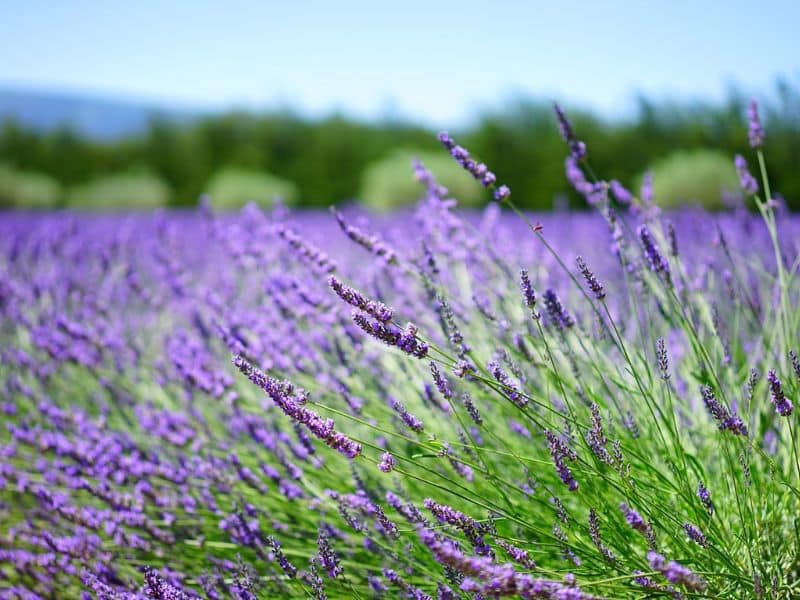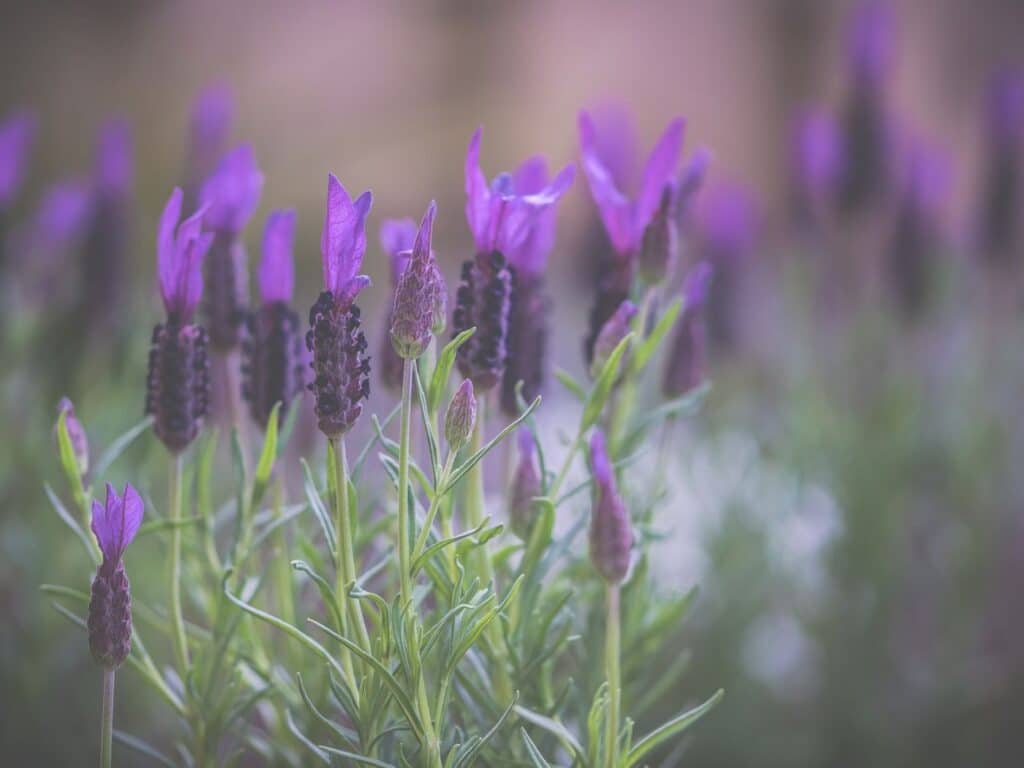Imagine walking out to your garden, expecting to see your beautiful lavender plants thriving, only to find them wilting and looking rather sad.
You’ve been diligent with your watering, so what could possibly be wrong? Could it be that you’ve loved them a little too much? Overwatering, a common mistake made by many garden enthusiasts, can be just as harmful as underwatering.
Signs of Overwatered Lavender
Watering your lavender too much can damage it. If you think your lavender may well be overwatered, look out for these typical signs.
Yellowing Leaves
Overwatering can cause your lavender’s leaves to turn yellow. It’s a common mistake to think that yellow leaves mean the plant needs more water.
However, yellow leaves may well indicate that you’re watering your lavender too much. If the leaves are yellow and droopy despite frequent watering, it’s time to cut back on watering.
Wilting Despite Wet Soil
Under healthy conditions, lavender enjoys slightly dry soil. If you notice wilting leaves despite wet soil, you’ve likely overwatered your lavender.
It’s not getting the oxygen it needs due to the oversaturation of water. Try allowing the soil to dry out thoroughly before watering again.
Root Rot Symptoms
Overwatering can lead to root rot, a serious problem for lavenders. Look for dark, mushy roots that may give off a foul smell. Clear signs of root rot are a weak, unstable plant or a lavender that’s wilting even after being watered.
Leaf Drop
A surefire sign of overwatering is excessive leaf drop. It’s normal for lavenders to lose some leaves, but if you notice a higher number of leaves falling, consider this a warning sign.
Look for unusually high leaf drop combined with other overwatering signs. Remember, the best cure for overwatering is prevention. Always check your lavender’s needs before adding more water.
Causes of Overwatering Lavender Plants

Overwatering your lavender plants isn’t just about giving them too much water—it can also be the result of certain conditions that promote excessive water retention. Under the following subheadings, let’s explore these factors in more detail.
Incorrect Watering Practices
It’s easy to mistakenly overwater lavender plants. Regular, shallow watering often does more harm than good. Instead of deeply soaking the root system, it keeps the surface soil constantly damp.
This dampness encourages root growth at the soil surface where water availability is inconsistent, leading to stress and overwatering symptoms in the plant. It’s also vital to remember that lavender plants require less water in cooler weather, so watering schedules should change with the seasons.
Inappropriate Soil Mix
The type of soil mix used can also contribute to overwatering problems. Lavender plants thrive in well-draining soil that recreates their natural habitat—rocky, sandy soil with a slightly alkaline pH.
If you plant your lavender in heavy, clay-rich soil or overly fertile potting mix, it retains water for too long. This excess moisture in the soil could lead to root rot, making it seem as if you’re overwatering your plant even if it’s receiving the right amount of water.
Poor Drainage in Planters
A recurring cause of overwatering lavender plants is trying to grow them in planters with poor drainage. Even if you’re watering them appropriately, without proper drainage, water can pool at the bottom of the planter.
This results in the soil staying overly wet for too long, leading to similar issues as overwatering. Always choose a planter for your lavender plants with sufficient drainage holes and consider using a well-draining potting mix to help prevent overwatering.
Preventing Overwatering in Lavender
Preventing overwatering in lavender plants requires knowledge of its specific needs. This section will guide you in achieving the right care to ensure your lavender’s overall health.
Choosing the Right Soil Mix
The right soil mix is crucial to lavender’s health. Opt for a light, well-draining soil mix.
This kind will allow sufficient air flow to the roots and prevent water from accumulating, reducing the chance of root rot. Examples are soil mixes with sand or small gravel, which improve water movement through the soil.
Understanding Lavender’s Water Needs
Lavender needs less water than you may well think. It’s a plant suited for a Mediterranean climate, and naturally thrives on dry, sunny exposure. Establish a watering routine based on the weather condition and plant size.
Smaller plants generally need more frequent watering, while mature plants fare better with deep watering less often. Remember, it’s always better to under-water than to over-water lavender.
Using Proper Drainage Solutions
Accompany your lavender planting with an effective drainage solution. Choosing pots with large drainage holes or adding a layer of small pebbles at the base can significantly reduce the chance of overwatering.
Outdoor lavender plants can benefit from raised planting beds or slopes, which encourage excessive water to flow away. Adopting these practices will help keep your lavender safe from the dreaded water-logging.
Steps to Save Overwatered Lavender
Overwatering can take a toll on your lavender’s vitality, but don’t lose hope just yet. There are actionable steps you can take, and a good chance your lavender can bounce back with a little TLC and patience. Let’s dive into the process.
Removing Affected Soil
First and foremost, gently remove your lavender plant, being cautious not to damage the remaining healthy roots. Immediate action is needed so start by removing the wet, compacted soil sticking to the root system.
Use a soft brush or your hands to do this but remember to be gentle. This rids the roots of excess moisture and begins the revival process.
Trimming Damaged Roots and Foliage
Next, delicately trim the damaged roots and foliage with a sanitized sharp tool. It may well seem counterintuitive to cut off parts of your lavender plant, but remember, overwatering often leads to root rot. Eliminating these affected areas helps prevent the spread of disease and encourages healthy growth.
Replanting in Fresh, Suitable Soil
Lastly, replant your trimmed lavender in an entirely new pot or garden bed. Use a mixture of well-draining soil and grit, which allows for better water control.
The soil should be light and airy, mimicking natural conditions for lavender growth. Always ensure you’re using a container with good drainage to prevent waterlogging. After repotting, water sparingly until you see signs of improvement.
Your lavender’s recovery journey may be slow, but with consistent care, it has a fair shot at flourishing again. Be patient and keep monitoring the plant’s progress closely.
Choosing Containers to Avoid Overwatering
The health of your lavender plants is profoundly impacted by the type of container you choose. Let’s dive right into the world of containers for lavender plants.
Types of Containers Suitable for Lavender
Several factors assist in zeroing in on the right kind of container for your lavender plants. It’s not just about aesthetics, but also functionality.
- Terracotta Pots: Terracotta pots are breathable and allow excess moisture to escape, promoting proper soil drying and discouraging overwatering. Keep in mind that these pots heat up quickly in direct sun and can accelerate soil drying.
- Ceramic Pots: Sturdier than terracotta, ceramic pots are also a viable choice. They maintain more consistent moisture levels, but you’ll need to monitor soil moisture regularly to avoid overwatering.
- Plastic Pots: Lightweight and affordable, plastic pots retain moisture for longer. However, they lack breathability, so they’re best used with a well-draining soil mix to prevent water retention.
Remember, the choice of container is directly linked to your watering habits and the local climate. Therefore, pick a container that complements these factors to facilitate the lavender’s healthy growth.
Importance of Drainage Holes
No matter what type of container you select for your lavenders, ensuring it has adequate drainage holes is non-negotiable.
- Water Disposal: Drainage holes assist in disposing of the excess water, hence, reducing the risk of overwatering and associated root rot.
- Avoids Soil Compaction: Drainage holes in containers help avoid soil compaction, which can inhibit the healthy growth of your lavenders.
- Promotes Root Health: Adequate drainage encourages oxygenation, fostering root health and preventing diseases associated with overwatering.
Long-Term Care for Lavender After Overwatering
Lavender, when overwatered, can bounce back with the right attention and care. Here’s what you can do for lasting resurgence.
Monitoring Water Intake
Even after addressing initial overwatering, it’s essential to watch your lavender’s water intake. Lavender plants prefer a “soak and dry” water method. Water the plant thoroughly, let the soil dry out completely, and only then water again.
Remember, lavender’s native Mediterranean environment is dry and sandy—emulate those conditions for a happy plant.
Regular Pruning Techniques
Your lavender plant will benefit from routine pruning. Aim to prune your lavender plant once a year, ideally at the end of summer after blooming has finished. By pruning back one-third to one-half of the plant, you encourage denser growth and continuous blooming in the following season.
Monitoring Soil and Drainage Health
Adequate drainage is crucial for lavender’s long-term health. Over time, soil can compact, reducing drainage efficiency. Regularly fluff your plant’s soil with a fork or your hands and watch out for signs of excessive moisture.
A good rule of thumb is to choose soil mixes that mimic the sandy, well-draining soils found in lavender’s native habitat. If changes to the soil’s structure or moisture levels occur, don’t hesitate to repot your lavender in fresh, well-draining soil.
Up next:







